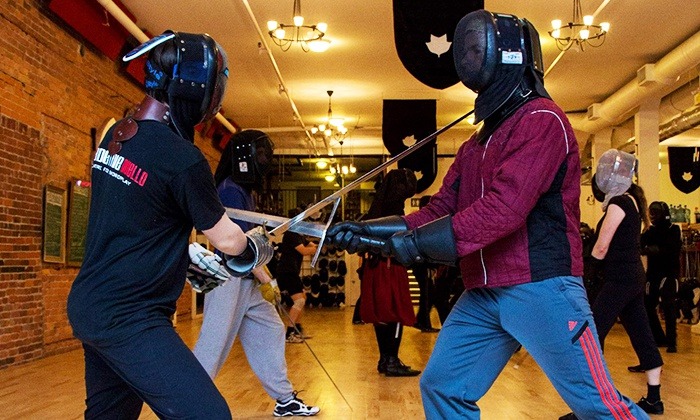Swinging a steel sword at someone, even a blunted one, seems risky. That's because it is.
How do we manage to practice an art that is traditionally deadly in a way that allows us to keep practicing it -- often rigorously -- for a long time?
There are three primary ways that we mitigate risks in martial arts:
Control
Physical control is the ability to have your weapon do exactly what you intend it to do. It is not about hitting lightly or hard, it is about hitting as you intend.
Self-control is the ability to check your intentions and act according to your goals. Good practitioners don't want to hurt their partners. It should be your goal to leave your fellow fencers healthier than they were when you found them.
Both of these types of control take time to develop and are central to being an excellent martial artist. By learning control we not only learn to be more effective and precise practitioners, we also develop greater self-discipline and self-awareness -- two of the deepest goals in martial practice.
Protective Equipment
Protective equipment allows us to apply higher levels of force and intensity or strike targets that are vulnerable even to blunted swords at slow speeds (such as your face). They are also one means of keeping ourselves and our partners safe while we learn to develop control.
It is important to recognize that protective equipment is not a replacement for control. No training sword nor type of armour keeps you safe on its own; a combination of appropriate protective equipment combined with respectful practice is what truly mitigates risk.
When you're first learning to develop control it is better to structure your practice to manage safety and healthy learning (i.e. doing things slower at first, or limiting your technical scope) than try to compensate through the use of equipment.
Personal Discretion
A post I read recently on the Flutter of Wings Tumblr about dealing with heavy hitters highlights this point well. If a situation you are entering seems unsafe, it's time to practice the discretion part of valour. This could mean telling your partner to slow down, taking yourself out of a practice or even a tournament bout, or letting an official know when an unsafe situation exists or might exist.
Look after yourself. Truly, you have nothing to prove. This is an art that you want both you and your friends to be able to practice well into the twilight of your lives. Be wise in how you practice and you will.
Academie Duello Instructor Intensive
Academie Duello’s next 50-hour Rapier and Longsword Instructor Intensive will take place October 17th to 21st in Vancouver, Canada. Throughout the week, you will learn the foundation of our approach to Italian Longsword and Rapier. Each day we will develop you as an instructor and practitioner through detailed lessons on mechanics, theory, pedagogy, and teaching methodology.
Based on over 20 years of martial arts teaching experience and 13 years as one of the world’s largest centres for swordplay, Academie Duello’s program is designed to make students into solid practitioners, learners, and teachers. Our curriculum has a strong basis in martial sources, practical experience, and sport science. The week is intense and rewarding and is followed by a mentorship program to help you solidify and more deeply integrate the lessons of the intensive.
Successful completion of the program qualifies you to examine for our Level 1 Instructor Certification. This permits you to facilitate an Academie Duello study group and continue your study in our programs with our active support. The course has value for all levels of experience and backgrounds.
Registration will open on August 14th at 10am. Space is limited. Our intensives fill quickly. Mark your calendars!
You can read more about our program here.
